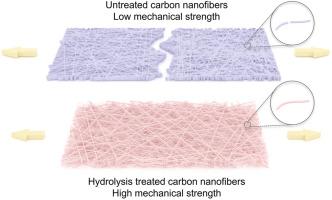Strengthening polyacrylonitrile-based carbon nanofibers via a hydrolysis-induced low-energy-barrier cyclization reaction
IF 4.1
2区 化学
Q2 POLYMER SCIENCE
引用次数: 0
Abstract
Electrospun polyacrylonitrile (PAN) nanofibers have been widely used as a precursor to fabricate high-quality carbon nanofibers (CNFs). However, the low degree of cyclization and breakage of fibers during the stabilization process severely restrict the mechanical properties of the final CNFs. In this work, we propose a novel strategy to enhance the cyclization by introducing carboxyl groups via hydrolysis. This treatment significantly reduces the cyclization energy barrier by facilitating an ionic pathway rather than a radical pathway. As a result, the degree of stabilization effectively increases from ∼45 % to over 60 %. Simultaneously, the cyclization temperature also reduces from 288 to 260 °C, corresponding to a gentler cyclization reaction, that can avoid stress concentration and thus eliminate the fiber breakage during heat treatments. These features lead to a remarkable enhancement on the tensile strength for CNF films, from 26.0 to 70.4 MPa. This hydrolysis-based stabilization optimization provides a straightforward method to strengthen CNFs, thereby extending their applications.


水解诱导的低能垒环化反应强化聚丙烯腈基碳纳米纤维
电纺丝聚丙烯腈(PAN)纳米纤维被广泛用于制备高质量的纳米碳纤维(CNFs)。然而,在稳定过程中纤维的低环化程度和断裂严重限制了最终CNFs的力学性能。在这项工作中,我们提出了一种通过水解引入羧基来增强环化的新策略。这种处理通过促进离子途径而不是自由基途径显著降低了环化能垒。因此,稳定度有效地从45%增加到60%以上。同时,环化温度也从288℃降低到260℃,环化反应更温和,避免了应力集中,从而消除了热处理过程中纤维的断裂。这些特性使CNF薄膜的抗拉强度显著提高,从26.0 MPa提高到70.4 MPa。这种基于水解的稳定化优化提供了一种简单的方法来强化cnf,从而扩展了它们的应用。
本文章由计算机程序翻译,如有差异,请以英文原文为准。
求助全文
约1分钟内获得全文
求助全文
来源期刊

Polymer
化学-高分子科学
CiteScore
7.90
自引率
8.70%
发文量
959
审稿时长
32 days
期刊介绍:
Polymer is an interdisciplinary journal dedicated to publishing innovative and significant advances in Polymer Physics, Chemistry and Technology. We welcome submissions on polymer hybrids, nanocomposites, characterisation and self-assembly. Polymer also publishes work on the technological application of polymers in energy and optoelectronics.
The main scope is covered but not limited to the following core areas:
Polymer Materials
Nanocomposites and hybrid nanomaterials
Polymer blends, films, fibres, networks and porous materials
Physical Characterization
Characterisation, modelling and simulation* of molecular and materials properties in bulk, solution, and thin films
Polymer Engineering
Advanced multiscale processing methods
Polymer Synthesis, Modification and Self-assembly
Including designer polymer architectures, mechanisms and kinetics, and supramolecular polymerization
Technological Applications
Polymers for energy generation and storage
Polymer membranes for separation technology
Polymers for opto- and microelectronics.
 求助内容:
求助内容: 应助结果提醒方式:
应助结果提醒方式:


